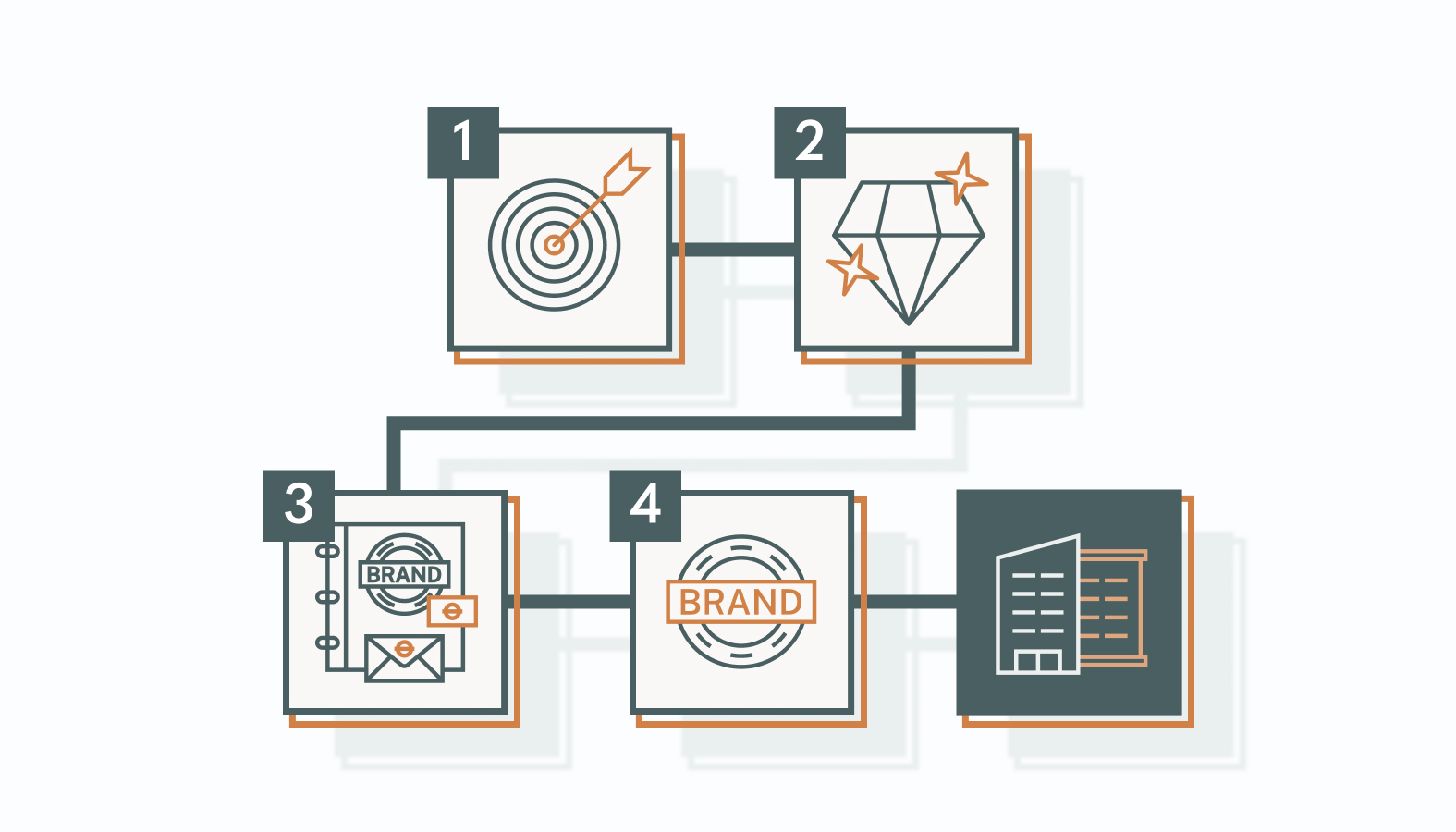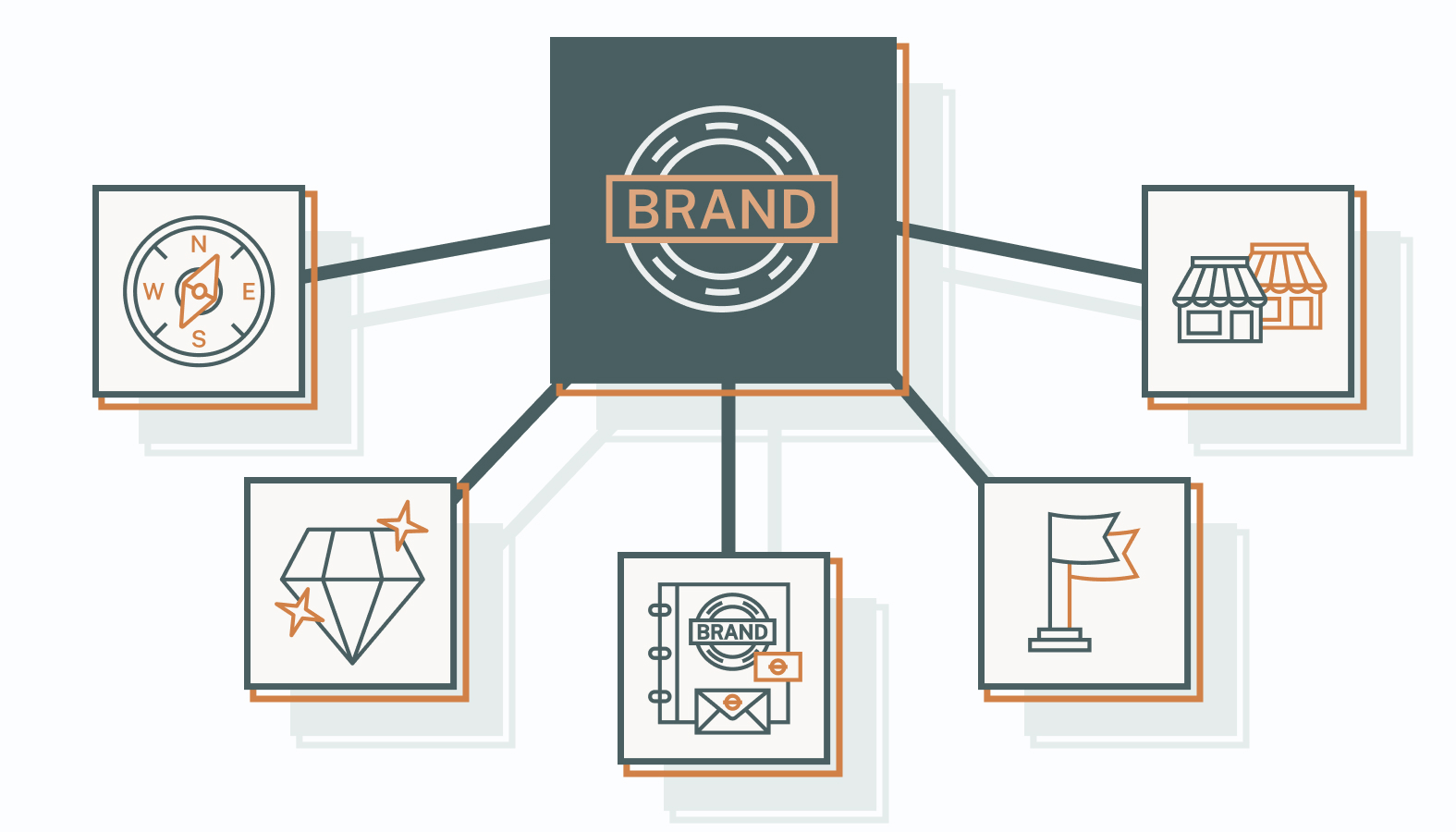In the sophisticated world of B2B, buyers are not merely browsing; they’re meticulously researching, comparing, and calculating. If your brand doesn’t project clarity, confidence, and undeniable value from the outset, you’re already at a disadvantage.
Strong B2B branding is a vital differentiator. It polishes your image, refines your positioning, hones your message, and builds trust, which is essential for securing complex deals and commanding premium pricing.
Yet, branding in B2B demands more than its B2C counterpart. It’s less about immediate attraction and more about sustained credibility. It’s not about impulse buys but about securing million-dollar commitments.
Even the most promising companies can fade into obscurity without a strategic focus.
This guide offers a practical framework for crafting a brand that captivates attention, drives revenue, and scales with your business. Discover how the savviest B2B brands break through, from positioning to perception to visual identity. Let’s get into it.
Mastering B2B Branding Fundamentals
B2B branding presents unique challenges and opportunities. Because you’re targeting other businesses rather than individual consumers, this approach would influence every aspect of branding, from strategy to execution.
B2B vs. B2C Branding: Key Differences That Shape Your Strategy
B2B and B2C branding strategies may live under the same marketing umbrella, but they speak entirely different languages because the people on the other end are fundamentally different.
In B2B, you’re not marketing to one person; you’re guiding a team of decision-makers through a high-stakes, often months-long buying process. You’re speaking to logic, efficiency, and long-term return on investment (ROI). Think enterprise software for IT leads and CFOs who don’t just pitch a product but position a solution that justifies the investment and moves the business forward.
B2C is a whole different ballgame. You’re engaging individuals, often emotionally. It’s personal. A brand like Nike isn’t selling shoes; it’s selling identity, aspiration, and lifestyle. The purchase cycle is faster, the messaging punchier, and the connection more visceral.
These distinctions shape everything from content type to distribution channels.
- B2B brands rely on high-trust content like case studies, white papers, and webinars delivered through platforms like LinkedIn or industry journals.
- B2C leans into scroll-stopping visuals, influencer endorsements, and quick-hit storytelling on Instagram or TikTok.
Both paths demand precision, but the tactics, tone, and touchpoints are tailored for entirely different journeys. Great marketers understand the difference and tailor their strategies accordingly.
Key Components of an Effective B2B Brand
A successful B2B brand relies on three critical components:
- strategic brand positioning,
- a well-defined brand voice, and
- a polished visual identity that work in lockstep.
Together, they form a cohesive and impactful brand image that builds trust, differentiates you in crowded markets, and drives long-term client loyalty.
Strategic Brand Positioning: Stand Out with a Clear, Defensible Niche
In the B2B context, brand positioning involves carving out a distinct niche in the market: defining what makes your brand unique and why businesses should choose you over your competitors. Whether it’s a tech edge, unmatched service, or niche expertise, your positioning should be clear, compelling, and defensible.
This involves clearly articulating your value proposition and competitive advantage, such as superior technology or unparalleled customer service.
Brand Voice: How Consistent Messaging Builds Trust and Authority
Your brand voice is your business’s personality. It’s how your business speaks and behaves in emails, proposals, web copy, social media, and beyond. It’s the tone that earns trust, signals authority, and makes your messaging stick.
The brand voice is crucial in B2B branding as it shapes perceptions and builds relationships with clients. A consistent, authoritative, yet approachable voice can establish trust and credibility, fostering long-term partnerships.
Visual Identity: Designing a Professional Look That Builds Credibility
Visual identity is your first impression and your brand’s visual handshake. Logos, typography, color systems, and layout standards should reflect professionalism, clarity, and consistency.
In industries where perception equals credibility, a well-crafted visual identity can tilt decisions in your favor before a single meeting.
The Value of Brand Equity in B2B
In the B2B sector, brand equity is a strategic asset that influences every business relationship. Beyond name recognition, it shapes how your company is perceived across every interaction, from first impressions to final negotiations.
A robust brand equity enhances a company’s reputation, fosters trust, and establishes credibility, ultimately influencing client decisions and partnerships.
Market Differentiation: Use Brand Reputation to Rise Above the Noise
Most B2B offerings look eerily similar from the outside. Brand equity crystallizes and elevates your unique value proposition with a reputation that precedes you.
Take a look at IBM. Its decades-long equity as a reliable innovator helps it stand out and justifies its position at the top of the enterprise tech ladder. Smart B2B brands do the same by leaning into their strengths and building a clear, consistent narrative around them.
Customer Loyalty & Retention: Build Trust That Keeps Clients Close
In B2B, loyalty isn’t about punch cards or perks. It’s about reliability and confidence over time, and high brand equity reinforces both.
Clients stick around and spend more when your brand is synonymous with follow-through.
Retention strategies should be built on consistency: exceptional service, proactive communication, and a commitment to quality that speaks louder than any sales pitch.
Premium Pricing: Justify Higher Prices with a Premium Brand Experience
Want to charge premium prices without constant pushback?
Build a premium perception. High brand equity enables companies to implement premium pricing strategies without compromising their market share.
Brands like Siemens don’t just sell features; they sell confidence, backed by decades of performance and innovation. When buyers view your brand as a safe bet with a measurable ROI, pricing becomes less of a friction point and more of a reflection of value.
Partnerships & Alliances: Use Brand Power to Open Strategic Doors
Strong brand equity drives customer loyalty and creates leverage at the highest levels. Partnerships, alliances, and joint ventures are easier to secure when your brand carries weight.
In negotiations, brand equity becomes an unspoken asset. It positions your company as the obvious partner of choice. Potential collaborators recognize the value in aligning with a trusted name, and the relationship is mutually beneficial from the outset.
Attracting Talent: Employer Branding That Draws and Retains Top Performers
People don’t just want to work at companies. They want to work at brands they respect. A well-regarded brand attracts top-tier talent and keeps them engaged.
But this doesn’t happen by accident. It requires intentional employer branding that highlights culture, growth opportunities, and a sense of purpose. When your external brand aligns with your internal reality, you become a magnet for high-performing individuals.
Step-by-Step B2B Brand Strategy Guide
Developing a robust B2B brand strategy requires a meticulous approach to ensure each component effectively contributes to the brand’s overall success. Every move, from market targeting to brand architecture, must be calculated, cohesive, and customer-informed.
A winning strategy aligns internal clarity with external impact. Let’s break down the key components.
1) Define Your Target Market: Reach the Right People with Precision
Your brand is only as strong as its relevance. That starts with precision targeting. In B2B, knowing your audience is not enough; you must also understand their needs, their structure, buying process, and pain points at a granular level.
To accurately identify and understand your target market, you must segment it based on:
- firmographics (such as industry, company size, and revenue) and
- psychographics (such as decision-maker motivations and internal challenges).
To create razor-sharp buyer personas, utilize a combination of qualitative and quantitative methods, including customer interviews, CRM data analysis, and competitor reviews. The goal is to deliver messaging that lands with the right people, in the right roles, at the right time.
2) Differentiate Your Brand: Create a Value Proposition That Sticks
Brand differentiation is extremely important in the B2B sector. Without it, you don’t have a competitive edge.
To achieve differentiation, start with your unique selling propositions (USPs), but go deeper:
What’s your actual edge?
Proprietary technology?
Next-level service?
Niche expertise?
Nail that, then build messaging around it that’s clear and compelling.
Differentiation isn’t just for first impressions; it sustains loyalty in long B2B sales cycles. When customers clearly articulate why you’re different, you’ve already won half the battle.
3) Develop a Cohesive Brand Identity: Align Visuals, Voice, and Values
Your brand identity isn’t just a logo and a font. It’s how the market feels about you before they ever speak to sales.
Visual consistency matters alongside a sharp brand voice, a clear mission, and a narrative that resonates across all channels. Your story should reflect the values, capabilities, and outcomes you deliver.
This goes beyond design aesthetics; it’s about ensuring strategic alignment across every brand touchpoint. When your brand identity is clearly defined and consistent, it builds trust, which drives conversions in the B2B space.
4) Organize Your Brand Architecture: Scale with Clarity, Not Confusion
If you oversee multiple brands, products, or business units, a well-structured brand architecture will help you maintain cohesion and keep everything functioning as a unified system.
Whether you operate under a branded house (like FedEx) or a house of brands (à la P&G), you need a clear framework that eliminates confusion, reduces internal friction, and amplifies market coverage. Poor architecture leads to cannibalization, brand dilution, and wasted resources.
A well-defined architecture clarifies how sub-brands relate to one another and to the parent brand. Done right, it provides flexibility to grow while maintaining brand equity. And most importantly, it ensures that every name in your portfolio is pulling its weight.
B2B Branding Services That Drive Real Results
Some marketing services have a greater impact on strengthening your B2B brand, elevating perception, reinforcing credibility, and driving meaningful growth.
Here’s what matters most:
Brand Assessments & Audits: Diagnose Before You Scale
Before you start scaling, you need clarity. Brand assessments are your diagnostic tools. They surface what’s working, what’s off-brand, and where untapped potential lives.
A thorough audit includes:
- Internal Review: Is your messaging aligned with your mission? Are your visuals and tone consistent across platforms?
- External Analysis: How do customers and competitors see you? Are you positioned to win in the current market?
- Feedback Collection: The gold lies in qualitative insights from customers, team members, and stakeholders. Their perception = your reality.
Done right, brand assessment and audits should be able to identify gaps and uncover opportunities for competitive differentiation.
Content & Digital Marketing: Educate, Influence, and Accelerate Sales
In B2B, your content is often your first impression, so make it count. Great content must inform, build trust, position your team as expert guides, and shorten sales cycles.
Key strategies include:
- Thought Leadership: Industry-specific insights, trend analysis, and POVs that reflect expertise and forward thinking.
- Webinars & Virtual Events: Show, don’t just tell. These activities are scalable, interactive, and prime venues for capturing intent-driven leads.
- Whitepapers & Reports: Deep dives that give your audience the data and answers they need to make decisions and remember your brand when they do.
The goal is to stay top of mind, even when your audience isn’t yet in-market.
SEO for B2B Branding: Get Found by the Right Decision-Makers
SEO (search engine optimization) is necessary in enhancing a brand’s online visibility and driving lead generation. This approach isn’t just about clicks; it’s about establishing authority and credibility. You want your brand to appear where decision-makers search, with content that’s actually worth reading.
By targeting keywords relevant to the business’s core audiences and services, brands can improve their search rankings.
Actionable SEO tactics include:
- Technical SEO: Ensure your website loads quickly, appears visually appealing on mobile devices, and integrates seamlessly with search engines.
- Intent-Led Content: Don’t chase keywords. Solve problems to earn both traffic and trust.
- Local SEO: Essential for regionally-focused services or satellite offices. Own your backyard first.
When done right, SEO becomes your 24/7 lead generator.
Social Media Strategy: Build Thought Leadership and Engagement at Scale
B2B buyers are on social media, and they’re paying attention. A strong presence on the right platforms builds credibility, expands reach, and nurtures relationships at scale.
Best practices:
- Channel Strategy: LinkedIn is your B2B powerhouse, but don’t overlook YouTube or X (Twitter) for thought leadership.
- Platform-Native Content: Tailor your content to the platform, don’t cross-post, and hope for the best.
- Performance Tracking: Engagement is nice. Conversions and quality leads are better. Measure what matters.
Your social feed should reflect your brand’s personality, values, and expertise, not just regurgitate blog links.
Customer Experience Management: Enhance Retention with Every Touchpoint
B2B success isn’t solely about winning new business, but also about retaining it. Exceptional CX is how you reduce churn, increase expansion, and turn clients into evangelists.
Invest in:
- Personalized Interactions: Make every touchpoint feel tailored and unique. Even your automated emails should convey a human touch.
- Proactive Support: Don’t just fix issues; anticipate them. That’s how trust is built.
- Feedback Loops: Continuously utilize client feedback to refine your services and stay ahead of evolving client needs.
Client experience should be a mindset that’s incorporated throughout your entire brand.
When these services are connected and consistently executed, you’re not just building brand equity but creating a competitive advantage that compounds over time. A high-performing B2B brand knows who it is, how to communicate value, and where to show up strategically (not sporadically).
Deciding When and How to Rebrand Your Business
In business, brands that adapt stay relevant, and those that don’t fade. A rebrand is a strategic recalibration.
When done right, rebranding revitalizes your market position, reconnects you with your audience, and aligns your business with its future direction. But timing matters. Here’s when and how to do it correctly:
Adapting to New Market Realities
Markets shift, technology disrupts, and consumer behavior evolves. A brand built for yesterday can’t win tomorrow. Rebranding in response to external changes is proactive risk mitigation.
Take Apple, for example. It evolved from “Apple Computer” to a lifestyle technology powerhouse as part of a company-wide survival strategy, market expansion, and identity realignment.
If your business model, products, or audience have changed but your brand hasn’t, you’re signaling the wrong story to the market.
- Respond to market, tech, or cultural shifts before you’re forced to.
- Ensure your brand evolves alongside your offerings and audience.
- Use rebranding as a tool for strategic repositioning, not just aesthetics.
- Learn from brands like Apple.
Refreshing Your Brand’s Look and Feel
Design is all about perception. A stale logo or clunky visual identity can make your business feel outdated even if your product isn’t. Updating your look (logo, type, color palette) signals progress. Just be sure it’s more than trend-chasing.
A successful visual refresh is guided by strategy: know your audience, align with your core values and stay consistent across every touchpoint. Cohesion builds trust, while a disconnect breaks it.
- Evaluate whether your visual identity still reflects your brand today.
- Update key brand elements (logo, typography, color palette) with purpose.
- Prioritize consistency across all brand touchpoints to build trust.
- Avoid design trends unless they align with long-term brand strategy.
Unifying Brands After Mergers or Acquisitions
Brand equity is on the table with M&A scenarios. When two (or more) brands come together, clarity is critical. The goal: one unified identity that respects legacy equity but builds toward a shared future.
Start with a brand audit. Identify what’s working, what’s redundant, and where audiences overlap. Then develop a new brand system that’s cohesive, relevant, and forward-facing. The merger should feel like evolution, not confusion.
- Begin with a thorough brand audit to evaluate strengths and overlaps.
- Identify legacy elements worth preserving.
- Build a unified brand architecture that reflects the new direction.
- Communicate clearly to avoid audience confusion and internal misalignment.
Aligning with Evolved Values and Mission
Brands are living systems. As your company’s mission, culture, or priorities shift, your brand must reflect that. Otherwise, customers and employees feel the disconnect.
Realignment isn’t just a copy rewrite; it’s a narrative overhaul. Redefine your story. Bake your new mission and values into every element, from your tagline to your tone. Internal buy-in is as important as external clarity. This is how brands evolve without losing their soul.
- Reassess your mission, vision, and values—what’s changed?
- Align messaging, tone, and visuals with your evolved identity.
- Engage employees early—internal clarity drives external impact.
- Ensure the new story feels authentic, not manufactured.
Standing Out in a Competitive Landscape
In saturated markets, differentiation is existential. Rebranding can sharpen your positioning, highlight your unique value, and give customers a clear reason to choose you.
Start with a competitive audit. Where’s the white space? What are others missing that you can own? Reposition your brand to speak directly to those unmet needs with precision and personality.
A solid rebrand must be focused. It shouldn’t try to be everything but commit to being something better.
- Conduct a competitive analysis to find gaps and opportunities.
- Define a distinct brand position based on customer needs, not just industry norms.
- Use tone, messaging, and design to emphasize what makes you different.
- Stay focused. Own one idea clearly rather than many vaguely.
Rebranding with Purpose, Scaling with Precision
B2B branding is a strategic infrastructure. From competitive audits to content strategy, every move you make should build equity, not just buzz. The right B2B branding services help you define your position, sharpen your value, and scale with purpose in volatile markets.
Whether you’re recalibrating after a merger, modernizing your visual identity, or evolving your brand to match a shifting mission, each decision should serve a bigger business objective. Strategy fuels relevance. Design signals trust. Consistency earns recognition.
When brand and business strategy operate in lockstep, you’re not just surviving change—you’re leading it.
Let’s Build a Smarter B2B Brand
You’ve seen what modern B2B branding demands: clarity, cohesion, and the courage to evolve. If your brand’s growth feels out of sync with your business’s direction, it may be time for a more strategic approach.
That’s where we come in. Our B2B branding services are designed to meet you where you are now and move you forward with intention.
Schedule a candid conversation with one of our experts and let’s discuss how to turn brand equity into business momentum.











